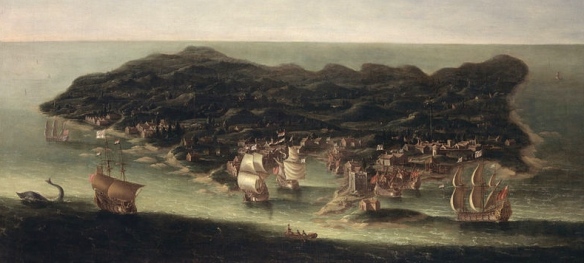
The Island of Barbados by Isaac Sailmaker, c1694 (Wikimedia Commons)
On 21 May 1700 the Paramore arrived at “Barbadoes” and anchored in Carlisle Bay, but this will be no island paradise for Halley as disease is rampant and the governor, Ralph Grey, advises him to leave quickly and prevent his men from going ashore – although, as these log extracts show, that advice is already too late for Halley:
[21 May 1700, extract] Yesterday about 5h in the afternoone wee raised the Island of Barbadoes, the midle of it bearing West halfe South by Compass 10 Leagues off. Wee Stood in wth. it till midnight, then wee Stood off and on till day… About noon wee ankor’d in Carlisle Bay in 5 fathome Water. Here I found his Majesties Shipp the Speedwell under Sail for England.
[22 May 1700, extract] I went up into the Country to Wait on the Governour the hon.able Ralph Grey Esqr. who advised me to make no more Stay than was absolutely Necessary by reason the Island had not been knowne so Sickly as at present, the Bridge Towne Especially, and for that reason to take care to keep my Men on board.
[24 May 1700, extract] I weighed from Barbadoes this Morning and whilst busey getting under Sail I found my Selfe Seized wth the Barbadoes desease, wch in a litle time made me So weake I was forced to take [to] my Cabbin. I order’d my Mate to shape his Course for St. Cristophers.
This is one of the few occasions that Halley is known to have fallen ill. He mentions a “quotidian Ague wch held me for some time indisposed” in a 1696 letter, and elsewhere a biographer tells us that when he was “attacked with a slight fever on catching cold, he used to take…half an ounce of Jesuit’s bark in water-gruel, which he called his chocolate, and by which he was always relieved.” [1] Quotidian ague? Slight fever? Clearly Halley was not the type to suffer that most alarming of ailments, the life-threatening ‘man-flu’.
Aside from the “Barbadoes desease”, his only known serious illness was the “paralytic disorder” he suffered about a year after his wife’s death, which left him with a paralysis in his right hand (he and Mary had been married for 54 years when she died in 1736). [2] Otherwise, he enjoyed good health and “preserved his memory and judgment to the last, as he did also that particular chearfulness [sic] of spirit for which he was remarkable.” [3] However, in his final year he was “wholly supported by such cordials as were ordered by his Physician [Richard Mead], till being tired with these he asked for a glass of wine, and having drank it presently expired as he sat in his chair without a groan” about three months after his 85th birthday. [4]
But what was the “Barbadoes desease” that Halley fell prey to in May 1700? Norman Thrower sought the opinions of several specialists in tropical diseases during the preparation of his edition of Halley’s voyages, and their conjectures included a gastro-intestinal illness, yellow fever (endemic in the Caribbean), and typhoid fever (because of a remark Halley will make in his next letter about his skin). [5]
It seems unlikely the disease can now be diagnosed with certainty, given how little Halley tells us about his symptoms, but if the conditions experienced by an earlier traveller to Barbados still obtained, then an infection spread via contaminated food and water seems probable.
In his 1657 work, A True & Exact History Of the Island of Barbadoes, Richard Ligon wrote that when he arrived at Barbados (1647) “the sickness raign’d so extreamly as the living could hardly bury the dead; and…they threw dead carcases into the bog, which infected so the water, as divers that drunk of it were absolutely poysoned, and dyed in a few hours after”, and later he noted that the Barbadians washed themselves and their linen in the pond water they used “to boyl their meat, to make their drink”, which he found “a little loathsome” and so took his own water from a nearby rivulet. [6]
We must hope that Halley, too, has refilled his cask from a less deadly source.
_______________
[1] Halley to ?Sloane, from Chester, Nov 1696, Royal Society EL/H3/51; Biographia Britannica, Vol IV (1757) p 2516, note bbbb.
[2] Biographia Britannica, Vol IV (1757) p 2516.
[3] Ibid.
[4] Ibid. Halley died on 14 January 1741/2.
[5] NJW Thrower, The Three Voyages of Edmond Halley in the Paramore, 1698-1701 (Hakluyt Society: London, 1981) p 46, note 3.
[6] R Ligon, A True & Exact History Of the Island of Barbadoes (London, 1657; 2nd edn, 1673) pp 25 and 28.
